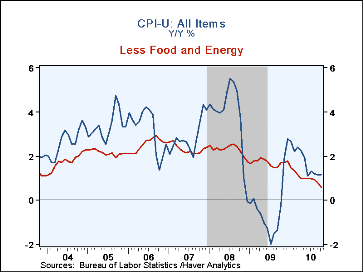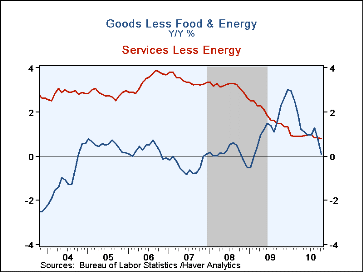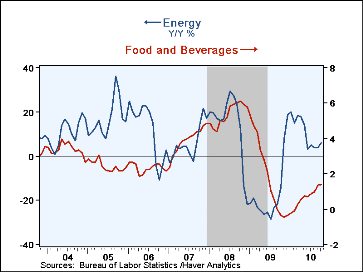 Global| Nov 17 2010
Global| Nov 17 2010U.S. CPI Moves Up Modestly As Core Prices Slip
by:Tom Moeller
|in:Economy in Brief
Summary
Consumer pricing power continues to suffer from inadequate economic growth and low levels of liquidity (money, loans, & earnings). That was clear in the report that the October Consumer Price Index ticked up just 0.2% after a 0.1% [...]
 Consumer pricing power continues to suffer from inadequate economic growth
and low levels of liquidity (money, loans, & earnings). That was clear in
the report that the October Consumer Price Index ticked up just 0.2% after a
0.1% rise during September. The gain was lower than Consensus expectations for a
0.3% rise. So far this year the CPI has risen at a 0.9% annual rate following
the 0.3% decline during all of last year.
Consumer pricing power continues to suffer from inadequate economic growth
and low levels of liquidity (money, loans, & earnings). That was clear in
the report that the October Consumer Price Index ticked up just 0.2% after a
0.1% rise during September. The gain was lower than Consensus expectations for a
0.3% rise. So far this year the CPI has risen at a 0.9% annual rate following
the 0.3% decline during all of last year.
The only real source of strength this year has been in energy prices. They rose 2.6% during October and at a 3.5% rate so far this year. Gasoline prices rose 4.6% last month and at a 5.1% rate since December. Fuel oil prices also were strong and rose 4.0% (NSA) last month and at a 6.4% rate this year but natural gas & electricity prices ticked up just 0.2%. They've been unchanged since December. Food & beverage prices rose 0.2% last month and at a 1.6% annual rate this year. Strength in meat, poultry, fish & eggs (6.5% since December) and dairy products (4.0%) has been offset by lower fruit & vegetable (-0.3%) and cereal (-1.3%) prices. The cost of eating out ticked is up at a 1.3% this year after a 3.5% 2009 gain.
Core consumer pricing power remained weak as prices excluding foods & fuel slipped after having been unchanged for two months. That lowered the y/y gain to 0.6%, the least since the series began in 1957. A 0.1% October uptick had been expected. Year-to-date prices rose at an even slower 0.5% annual rate. Core goods prices fell 0.2% for the second month and they're down at a 0.3% rate since December, despite a 5.8% rise in tobacco prices. New and used motor vehicle prices slipped for the second month but they've risen at a have risen 1.3% rate this year while prices of home furnishings & operation have fallen at a 2.7% rate. Apparel prices slipped for the third consecutive month and at a 1.6% rate this year.
Core services prices also have shown little strength this year. They again rose just 0.1% and at a 0.8% rate since December. Medical care continued as an area strength posting a 0.2% increase and a 3.7% (AR) gain since December. Education costs were unchanged during October but they too have been strong posting a 3.6% gain (AR) this year after 5.3% last year. Easier shelter costs have offset this strength and have fallen at a 0.2% rate this year. Owners equivalent rent of primary residences, a measure not equivalent to other house price measures, ticked up 0.1% after a 1.7% gain in 2009. These latest readings are the weakest since the series' start in 1983. Public transportation costs rose 0.2% and at a 1.2% rate this year after last year's 5.6% decline.
The chained CPI, which adjusts for shifts in consumption patterns, rose 0.2% and 1.0% year-to-year. Chained prices less food & energy ticked 0.1% higher and 0.3% y/y.
The consumer price data is available in Haver's USECON database while detailed figures can be found in the CPIDATA database.
| Consumer Price Index (%) | Oct | Sept | Aug | Oct. Y/Y | 2009 | 2008 | 2007 |
|---|---|---|---|---|---|---|---|
| Total | 0.2 | 0.1 | 0.3 | 1.2 | -0.3 | 3.8 | 2.9 |
| Total less Food & Energy | -0.0 | 0.0 | 0.0 | 0.6 | 1.7 | 2.3 | 2.3 |
| Goods less Food & Energy | -0.2 | -0.2 | 0.1 | 0.1 | 1.3 | 0.1 | -0.4 |
| Services less Energy | 0.1 | 0.1 | 0.0 | 0.8 | 1.9 | 3.1 | 3.4 |
| Energy | 2.6 | 0.7 | 2.3 | 5.9 | -18.1 | 13.7 | 5.6 |
| Food & Beverages | 0.1 | 0.3 | 0.1 | 1.4 | 1.9 | 5.4 | 3.9 |
| Chained CPI: Total (NSA) | 0.2 | 0.1 | 0.1 | 1.0 | -0.1 | 3.7 | 2.5 |
| Total less Food & Energy | 0.1 | 0.1 | 0.1 | 0.3 | 1.5 | 2.0 | 1.9 |
Tom Moeller
AuthorMore in Author Profile »Prior to joining Haver Analytics in 2000, Mr. Moeller worked as the Economist at Chancellor Capital Management from 1985 to 1999. There, he developed comprehensive economic forecasts and interpreted economic data for equity and fixed income portfolio managers. Also at Chancellor, Mr. Moeller worked as an equity analyst and was responsible for researching and rating companies in the economically sensitive automobile and housing industries for investment in Chancellor’s equity portfolio. Prior to joining Chancellor, Mr. Moeller was an Economist at Citibank from 1979 to 1984. He also analyzed pricing behavior in the metals industry for the Council on Wage and Price Stability in Washington, D.C. In 1999, Mr. Moeller received the award for most accurate forecast from the Forecasters' Club of New York. From 1990 to 1992 he was President of the New York Association for Business Economists. Mr. Moeller earned an M.B.A. in Finance from Fordham University, where he graduated in 1987. He holds a Bachelor of Arts in Economics from George Washington University.








